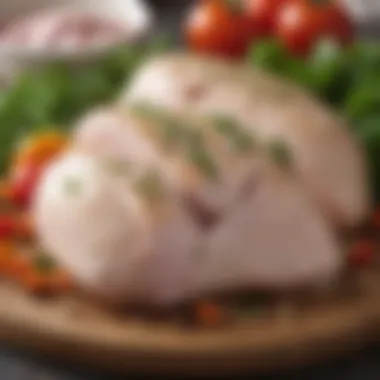Grain-Free Chicken Recipes for Healthy Dogs


Intro
Creating homemade grain-free meals for dogs is an art and a science. With an increasing awareness of canine nutrition, many dog owners are turning towards grain-free diets. Chicken, being a high-quality protein source, serves as an excellent base for these recipes. The desire to nurture our pets with better food choices drives this growing trend. In this guide, we explore the practical steps to prepare tasty grain-free chicken recipes.
The following sections will delve deep into various recipes, offering detailed instructions, variations, and time-saving tips. Each recipe featured will not only sustain your dog’s appetite but will also cater to their health needs. You might wonder how to balance nutrition, meal preparation time, and quality. We aim to answer that and much more in the upcoming segments.
Understanding Grain-Free Diets
A grain-free diet has garnered attention among pet owners seeking options to enhance their dogs' health and well-being. Grain-free diets can help avert potential allergies and support optimal digestion. This section highlights the fundamental aspects of grain-free nutrition, evaluates reasons behind this diet, and discusses vital nutritional considerations for our canine companions.
Defining Grain-Free Nutrition
Grain-free nutrition refers to a dietary approach in which cereals, such as wheat, corn, and rice, are excluded from meals. This method often involves incorporating alternative ingredients, like vegetables and fruits, allowing dogs to obtain energy from diverse sources while preserving overall wellness. Given that some dogs may struggle to digest grains properly, grain-free nutrition can streamline their digestion and generally improve nutrient absorption. Understanding these core tenets can aid in making informed dietary decisions for dogs.
Reasons for Adopting Grain-Free Recipes
There are several reasons pet owners have embraced grain-free dietary approaches for their dogs:
- Allergies and Intolerances: Some dogs are sensitive to common grains, leading to gastrointestinal issues or skin irritations. Salt and high sugar levels can contribute to these ailments. Grain-free alternatives can negate these reactions.
- Improved Digestion: Certain dogs thrive on diets devoid of grains. Higher protein content can potentially be easier on their systems.
- Raw and Natural Eating Philosophy: Some pet owners are drawn to a raw or whole-food approach. Grain-free recipes often align with this mindset, aiming for a more ancestral diet.
By exploring these reasons, pet owners can make decisions that favor the individual dog's experience and health.
Nutritional Considerations for Dogs
Formulating grain-free meals must adequately consider essential nutrients. Achieving balance and nutrition in these new recipes is crucial to dogs' longevity and longevity of condition.
Essential Nutrients for Canine Health
To maintain optimal health, dogs need appropriate nutrients in their diets. Vital components include proteins, vitamins, minerals, and omega-3 fatty acids. A focus on essential nutrients for canine health facilitates well-functioning systems and supportive immunity. For instance:
- Amino acids from proteins enable muscle development and recovery.
- Vitamins promote proper metabolism and support bodily functions. On the other hand, mineral intake contributes to bone strength.
With grain-free diets, attention should be exercised to avoid deficiencies, thereby ensuring dogs receive adequate nourishment from other sources. This aspect makes it necessary for pet owners to become astute in ingredient selection.
Protein Requirements for Active Dogs
Protein requirements intensify for active dogs engaged in regular exercise or guide roles. Adequate protein source consumption is essential to maintain muscular function and energy levels for ongoing activities. Ingrain-free chicken recipes, adequate planning ensures these canine powerhouses receive sufficient protein, accommodating their higher needs and helping facilitate recovery and stamina. Traditionally those active dogs benefit retiring world better overall narrative surrounding dietary health and physical prowess.
Benefits of Chicken in Dog Food
Chicken is a prominent ingredient in many homemade dog recipes. It holds above many other meat sources in terms of nutritional benefits and relevance. Understanding the specific advantages of chicken sheds light on its principal role in a dog's diet, especially when considering grain-free options.
High Protein Source
Chicken serves as a high-quality protein source. The protein found in chicken is essential for your dog's muscle growth and maintenance. As many dogs are naturally active, this protein aids in repairing the damage to muscles sustained through their daily activities. Many formulas with chicken can have protein content approximately between 20-30% of total weight, depending on preparation methods. Overall, such significant protein levels facilitate gains in strength and improved energy levels.
Easy to Digest
For dogs, chicken is notably easy to digest compared to other meat proteins. Unlike beef and pork, chicken has a more simplistic amino acid structure. This simplicity makes it less likely to cause gastrointestinal issues. Many dogs struggling with allergies or sensitive stomachs can benefit significantly from chicken in their meals. It supports proper digestive health and allows the dog's body to absorb the recalled nutrients more efficiently.
Versatility in Cooking


One notable factor about chicken is its versatility. There are numerous methods to prepare chicken, making it a transitional ingredient for various recipes, including stews and treats. Some popular cooking methods include boiling, baking, and grilling. Each method has its own benefits regarding how flavors are presented and how easily the meat can be prepared. These adaptable cooking styles allow dog owners to explore and concoct creative recipes that maintain freshness and enrich the dietary choices possibly available to their dogs.
Chicken is the primary protein used in multiple diets tailored for dogs, making it a crucial element in many canine recipes that prioritize health and ease of preparation.
In sum, integrating chicken into your dog's diet provides essential protein, ease of digestion, and flexibility in culinary approaches. Its potential to deliver breed-specific and age-specific solutions makes it a top choice for homemade grain-free meals.
Choosing Ingredients for Homemade Dog Food
Choosing the right ingredients for homemade dog food is essential. Quality ingredients directly affect the nutritional value and the overall health of your dog. When thinking about meal preparation, one must consider both the health benefits and the preferences of the dog. Good ingredients can lead to a healthier, happier pet.
Selecting Quality Chicken
When preparing grain-free chicken recipes, using high-quality chicken is vital. Look for chicken that has been sourced from sustainable farms. It is best to choose free-range or organic chickens if possible. These sources are often raised without antibiotics or hormones, which can be harmful to both dogs and people.
Chek the label to ensure you are getting all strips of chicken, as some cuts provide more nutrients than others. For instance, darker meat, such as thighs, contains more fat, while breasts tend to be leaner. Either way, make sure to cook the chicken properly before servings, as raw meat may carry bacteria.
Incorporating Vegetables
Adding vegetables to dog food can significantly enhance its nutritional profile. Many vegetables provide essential vitamins, minerals, and antioxidants. The variety of textures and flavors also keeps meals interesting for dogs.
Beneficial Vegetables for Dogs
Certain vegetables are excellent for dog meals. Carrots, green beans, and sweet potatoes can be great additions. Each of these vegetables has key traits. For instance, carrots improve eye health due to beta-carotene while sweet potatoes offer digestive fats.
These vegetables are beneficial because they can also be more digestible than grains. Moreover, these provide energy boosting without introducing potentially harmful grains. Selecting a mix of different vegetables can also promote a balanced diet, thus benefiting the overall well-being of your dog.
Vegetable Preparation Methods
Proper preparation of vegetables for canine consumption is crucial. Dogs digest differently than humans so some methods include steaming, pureeing or even baking vegetables may help. Steaming softens the fibers while preserving nutrients. Cooking can remove substances that are hard on a dog's stomach, making them easier to consume.
In addition, avoid using seasoning or anything that might be toxic to dogs during cooking, like onions or garlic. Stick with simple, fresh, and plain methods to keep it healthy. When added correctly, vegetables can provide diversity in meals and optimize the health benefits for the dog.
Inclusion of Healthy Fats
Healthy fats are another important component of homemade dog food. They can provide energy, help with absorbing vitamins, and improve the skin and coat health. Consider sources like olive oil or fish oil, as each includes essential fatty acids. Balance these fats while planning the recipes, ensuring they complement the protein sources well. This way, dogs enjoy both taste and health at every meal.
Grain-Free Chicken Recipes for Dogs
Grain-free diets have gained popularity in the dog food world. Many dog owners are seeking alternatives to traditional kibble, not only for health reasons but also for their pet's discerning tastes. Grain-free chicken recipes address these concerns effectively, providing crucial nutritional benefits for dogs. Using chicken as a core ingredient, these recipes emphasize wholesome, digestible ingredients. Additionally, these recipes are ideal for pets that have grain sensitivities or allergies, contributing positively to their overall well-being without compromising taste.
Simple Chicken and Vegetable Stew
Ingredients List
The ingredient list is fundamental for creating effective dog recipes. In a simple chicken and vegetable stew, core ingredients may include boneless chicken breasts, carrots, peas, and chicken broth. Each component plays a vital role in ensuring a balanced meal for dogs. The chicken serves as the primary protein source, essential for muscle development and energy. Vegetables like carrots add fiber and are rich in vital vitamins and minerals. Having fresh, high-quality ingredients form a nutritious base is especially important in maintaining a dog's health.
Step-by-Step Preparation
Preparation must be straightforward to handle busy schedules and varying skill levels. Every step in the recipe offers a smooth workflow for creating this stew. First, boiling the chicken in chicken broth enhances flavors without harmful additives. Chopping vegetables promptly ensures they cook evenly and retain their nutrients throughout the cooking process. Following concise steps helps busy pet owners engage more confidently with the recipe, enriching their dog's meals without unnecessary complexity.
Chicken and Sweet Potato Mash


Essential Ingredients
The appropriate choice of essential ingredients can enhance a recipe's effectiveness in promoting dog health. For chicken and sweet potato mash, the fundamental components are ozhar chicken, sweet potatoes, and a splash of coconut oil. These ingredients blend tastiness and nutritional value. Sweet potatoes provide high fiber, while coconut oil can improve skin condition. Both contribute significant carbohydrates, sustaining energy levels during active periods. Kenning these specific ingredients can bridge nutrition for dog owners who demand quality in their pets' diets.
Cooking Instructions
Clearly outlined cooking instructions foster ease of preparation and handling. The first step often involves boiling sweet potatoes until soft enough for mashing. Incorporating transformed chicken augments protein content without extra effort. This point particularly helps non-expert cooks feel adequate when preparing food for their dogs. A methodical approach reinforces their confidence in home cooking as a viable option, contributing to a nutritious alternative to store-bought dog food.
Homemade Chicken Jerky Treats
Required Ingredients
Focusing on required ingredients signifies lots of aspects of care for pet development. Essential ingredients include chicken breast filets and specific seasonings, such as garlic powder or parsley. Chicken breasts provide protein and when dehydrated create delightful, nutritious treats dogs love. Ensuring these ingredients are human-grade guarantees a healthier treat that aligns with higher manufacturing standards. Moreover, ensuring the right balance can pull your dog's attention to these treats, trained for their effectivity ways.
Drying Techniques
Employing effective drying techniques is imperative to maintain taste and shelf life for jerky. There are varied approaches like using a dehydrator or oven drying. Setting correct temperatures while comprehensively timing prevents nutrient loss or spoilage. Pets benefit from treats that not only taste good but are also easy on their stomachs. Facilitating these techniques provides an opinion for ensuring that dog owners can produce their own safe snacks at home, delivering controlled nutrition and peace of mind.
All these processes fundamentally emphasize suitability and nutritional balance, assuring pet owners who integrate grain-free chicken recipes can deliver remarkable meals full of health benefits to their dogs. Remembering their dietary needs ultimately leads to rewarding outcomes for both our furry friends and us.
Common Mistakes to Avoid
Understanding key mistakes is essential when preparing grain-free chicken recipes for dogs. While intentions may be good, oversights can lead to problems. Addressing these errors can improve nutritional values and enhance the overall health of your dog.
Overlooking Nutritional Balance
Many pet owners focus on one aspect of nutrition, such as protein content, while neglecting the overall balance. Dogs require a diverse range of nutrients in their diets. This includes vitamins, minerals, and fiber. Without this balance, health issues may arise.
Grain-free diets can provide high protein, but if not approached thoughtfully, they miss essential nutrients sourced from whole grains and certain vegetables. Consulting with a veterinarian or canine nutritionist can help in understanding the proper nutritional balance for your dog's specific needs.
Important Points to Consider:
- Ensure that the complete diet has enough vitamin A, D, and E, plus B vitamins.
- Include essential fatty acids for healthy skin and fur.
- Fiber is crucial for digestion, so incorporate plenty of healthy vegetables.
Improper Ingredient Choices
Choosing the wrong ingredients can be detrimental. Not all chicken or vegetables are created equal. For example, using fatty cuts of chicken may upset a dog’s stomach or lead to unhealthy weight gain. Additionally, some vegetables are toxic to dogs, such as onions or garlic.
When selecting ingredients, always consider:
- The source and cut of the chicken. Choose lean options, like chicken breast, instead of skin or fatty parts.
- Knowing which vegetables are safe. Carrots, peas, and green beans are good choices, whereas others might cause sickness.
- Avoid processed items that may contain preservatives or unhealthy fillers.
Neglecting Food Safety Practices
Food safety is crucial in homemade dog food preparation. Neglecting this aspect can cause foodborne illnesses that affect both dogs and their owners. For example, not cooking chicken thoroughly can lead to salmonella contamination.
To keep health risks low, adopt the following food safety measures:
- Always cook chicken to an internal temperature of 165°F (73.9°C).
- Refrigerate leftovers promptly to prevent the growth of harmful bacteria.
- Be mindful of cross-contamination; use separate utensils for dog food.
Following these safety measures can help maintain good practices and contribute to the well-being of your dog.


Understanding these common mistakes can lead to better choices. Fostering a well-rounded, safe, and nutritious feeding routine will pave the way for more enjoyable homemade meals.
Transitioning Dogs to Grain-Free Diets
Transitioning a dog to a grain-free diet is an important consideration for pet owners keen on improving their dog’s nutritional health. Grain-free diets often focus on high-quality proteins and vegetables that align better with a canine's natural eating principles. This switch can greatly impact a dog’s overall wellness. However, it is vital to carry out this transition gradually, ensuring that the dog's digestive system can adapt appropriately.
Many dogs face intolerances or allergies to grains, and a sudden change might lead to digestive upsets. Furthermore, monitoring the dog's health and behavior is crucial during this period. It helps the owner identify any adverse reactions early on to ensure the dietary changes positively contribute to the dog’s health.
Gradual Prolusion
When transitioning your dog to a grain-free diet, a gradual introduction is more beneficial than an abrupt switch. This method involves a slow mix of the new grain-free food with the current food. Start by replacing about 25 percent of the existing food with the new grain-free dry or wet dog food. Gradually increase the proportion of the grain-free component over seven to ten days. This approach generally allows the dog's digestive system time to adapt.
- Start your dog's transition with small amounts of grain-free elements mixed into their current meal.
- Gradually increase the portion of the grain-free diet.
- Monitor your dog for any signs of digestive distress, such as vomiting or diarrhea.
- Maintain communication with your veterinarian through this process to address any concerns.
By handling the introduction mindfully, you not only support redirection in diet but also uphold your pet's comfort and health.
Monitoring Health and Behavior
Throughout the transition phase, monitoring health and behavior stands as a pivotal task for dog owners. Pay close attention to any visible changes in bowel movements, energy levels, and skin conditions. Maintaining a record will allow for clearer insight into how well the new diet is received by the dog.
Make it routine to observe your dog during the process by checking:
- Behavioral changes: Is your dog more energetic or more lethargic?
- Physical changes: Look for any skin irritations, coat dullness, or changes in weight.
- Digestive reactions: Adjustments during this phase might include instances of flatulence, diarrhea, or changes in stool quality.
- Recovery: In cases of negative reactions, reverting to the prior diet while monitoring repairs might be prudent.
Always consult animal care professional when in doubt about health aspects related to diet.
By overseeing these elements attentively, pet owners can ensure that the transition to grain-free feeding is successful in enhancing their dog’s overall well-being.
Closure
In this article, we have examined the significance of grain-free chicken recipes for dogs. Grain-free diets can be a reasonable solution for dogs with specific dietary needs or sensitivities. They provide an alternative to traditional dog foods, often enhancing overall health. Creating meals at home allows owners to exert control on ingredient choices, ensuring those are fresh and wholesome.
Understanding the selections for your dog’s meals proves essential. By recognizing their nutritional requirements, you can ensure their meals offer not just flavor but also beneficial elements needed for sustained energy and good health. The exploration of chicken as a primary protein source contributes to this goal, providing high-quality nutrition essential for maintaining optimal canine health.
There are direct benefits involving homemade recipes as well. They provide you flexibility. You can cater specific diets based on your dog’s health status or preferences. Clearly laying out the steps and considerations involved in transitioning to grain-free diets improves your confidence in undertaking meal preparation.
As responsible pet owners, we should prioritize not only what our dogs enjoy but also what supports their long-term health.
Summary of Key Points
Understanding grain-free options entails acknowledging many details that factor into health and dietary needs. At the core of this understanding is a few vital points:
- Grain-free diets can alleviate specific health conditions among dogs, such as allergies.
- Chicken serves as a rich and nutritious protein source that is easy to digest.
- Homemade recipes offer an alternative to commercial dog food that allows clearer control over nutrition.
- Ingredients matter; always select food items with care while incorporating beneficial elements.
- Gradually introducing diet changes is crucial to ensuring the well-being of your dog.
This overview showcases validated cannes in achieving an improved dietary framework and lifestyle for dogs.
Encouragement to Experiment with Recipes
Trying out grain-free chicken recipes is a valuable experience for both you and your dog. You have the chance to become more acquainted with your dog’s preferences and nutritional needs. Do not feel confined to stipulated recipes. Start by following provided guidance, but also spark creativity.
Experimentation could mean trying unique combinations in meals based on whatever remains in your pantry or personal tastes.
Consider including:
- Different vegetables that are safe for dogs, defintely things like sweet potatoes and carrots.
- Adjusting the texture—from finely mashed to chunky preparations—might make meals more enjoyable.
- Gradually alter flavor profiles by integrating herbs like rosemary or parsley, used appropriately in dogs' diets.
Food and DOT underscore companionship along with nourishment. Therefore, the meals you provide are a form of care and love for your dog.







